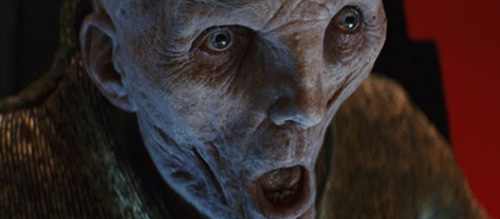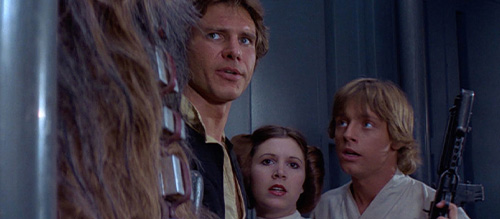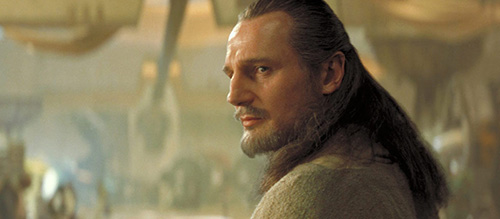Modern Problems Require Modern Solutions: Expectations of Star Wars Lore in the 21st Century
A post on /r/StarWars led to a contentious comments section, with users debating whether Snoke’s present lack of on-screen character development and backstory is detrimental to the franchise. The frustration with with Star Wars’ new Emperor analogue can be best summarized by a comment from /u/agoddamnjoke:
“Snoke is such a joke. I can’t believe people defend how little depth he’s gotten. He is the crux of everything that happened in the ST. Has intimate knowledge of the main characters from the OT. And yet gets cut down monologuing like a Bond villain.
Why didn’t Luke do anything about him? What was he doing during the Ot. What was he doing after? Don’t give me we didn’t know about the emperor either because that isn’t the same thing. OT was our first introduction into the universe. We knew what we needed to. Then we got background. But we’re not getting prequels to the sequels lol.
And this comic still didn’t offer any background. TRoS is going to have to pull out all the stops to have to try and explain everything and move the story forward.”
The most common rebuttals fall into two camps: there’s the “wait until The Rise of Skywalker is out to judge” line of thinking, or the group that says “the Emperor’s story wasn’t vital to the Original Trilogy, and Snoke’s isn’t either”. I think this debate outlines a fundamental change in the expectations of film fans since the late 20th century, specifically for Star Wars fans, when it comes to lore and world building.
The Film Magazine on Reddit: r/TheFilmMagazine.
Back to the Future illustrates the fundamental difference between how films approached worldbuilding then versus now. When Zemeckis and Gale created the series, they didn’t think about time travel the way we do – they didn’t even have the word multiverse, a concept so commonplace that the show ‘Rick and Morty’ (which is loosely based on BttF) was built around it. Viewers are more likely to take careful note of the film’s world and rules in order to deconstruct and find the holes in what’s given to them because, frankly, it’s fun to do. In BttF, Marty goes back in time and has the ability to actually affect his future to the point he erases himself from existence. He time travels on a single line – one that does eventually branch into an alternate timeline in BttF 2– but that line merges back once the past has been fixed. According to fans and scientists, this shouldn’t be possible, and the “erase from/change” existence concept leads to a situation where the DeLorean shouldn’t even exist in the first place. Endgame corrects the issues caused by that set of rules, explaining that it is impossible to interact with your “true” past self because the “past” is really a parallel reality, therefore eliminating the ability to erase or change the future.
We’re now 20 years removed from The Phantom Menace, and Star Wars has only gotten bigger (it was pretty big in 1999). The more hardcore fans were deep into the Expanded Universe by that point, with stories like the “Thrawn” trilogy, “Jedi Academy” trilogy, “X-Wing” series, “Young Jedi Knights” series, and one-offs like “Splinter of the Mind’s Eye” and “Tales of the Bounty Hunters” changing their perception of the series as something more intricate and sweeping than just three films. While the majority of these novels took place post-Return of the Jedi, some did take place prior to The Battle of Yavin, noted in a list from Stack Exchange (I can’t say for sure if they were affected by TPM, but judging from their titles, I’d assume there’s no conflict. Lucas did not allow prequel works that involved Anakin or the Emperor due to his upcoming films). Whether this was a result of changing times or part of the catalyst for change itself, I couldn’t tell you, but the PT assuredly is the final nail in the coffin for simplicity in the expectations of Star Wars fans.
Unfortunately for fans and creators, that simplicity is a trademark of the Original Trilogy. For all the background the series has developed since Star Wars (1977), everything you really need to know is contained within the original three films. The story isn’t about Anakin or Palpatine, it’s about Luke, Leia, Han and their crew. It’s about toppling the evil Empire and fulfilling heroic destiny. Obi-Wan and Darth Vader convey bits and pieces about the Senate, Clone Wars and the identity of Luke’s father in several scenes throughout the original that serve as brilliantly minimal world building; Obi-Wan and Yoda also teach Luke and the viewer about Jedi history, philosophy and worldview, something that is covered much deeper in the PT and ‘Knights of the Old Republic’ video games.
Star Wars and Empire outline the core Jedi beliefs. Obi-Wan says, “The Jedi Knights were the guardians of the peace and justice in the Old Republic. Before the dark times, before the Empire… now the Jedi are all but extinct. Vader was seduced by the dark side of the Force.” What more does a viewer need to know about the Jedi at this point in the story? Luke isn’t even necessarily interested in a history lesson, just background on individuals that he has a personal connection to. Obi-Wan’s deceit about Vader’s identity shows that the Jedi look at things from a certain point of view that isn’t as absolute as that of the average person. Yoda and Obi-Wan’s teachings show the Jedi’s connection with the Force is their most powerful tool. Yoda also expounds on the power of the dark side’s lure as a quicker, easier route to power that feeds on base emotions. This is all conveyed during sequences of a type that don’t exist in the PT, slowing the pace of the films to express the philosophical and meditative focus of the Jedi through the story structure.
Visually the films are a spectacle because of their groundbreaking practical effects, but the OT doesn’t hinge on its action. The lightsaber fights contain conversation that puts the philosophical struggle on equal footing with the physical fight. “Obi-Wan has taught you well. You have controlled your fear… now release your anger,” Vader tells Luke during the duel in Empire. Luke stays controlled, not giving into Vader’s jeers and taunts. We know the power of Darth Vader from his duel with Obi-Wan, and Luke demonstrates the emotional fortitude that is required of a Jedi in both Empire and Jedi, resisting the lure of the dark side. Even in defeat, Luke refuses to give in and join with Vader, even at the chance to rule without the Emperor. All of this occurs without Luke practicing his lightsaber dueling technique; it’s the power of the Force that guides him, and his devotion to the light side that gives him strength.
Recommended for you: 5 Most Profound Moments from ‘Star Wars’ (1977)
In contrast, the Prequel Trilogy is too focused on expanding the universe, and is held back by a convoluted plot. The entirety of the fabricated trade dispute between Naboo and the Trade Federation in TPM and carefully plotted civil war in Attack of the Clones feels so stupid when compared with the OT’s storytelling. The story is intricate, showing how Palpatine created galactic conflict through various ploys, moving across many planets along the way as the protagonists work to untangle the web. Characters like Dexter Jettster, Boss Nass, Zam Wessell, Chancellor Finis Valorum or Jedi Master Syfo-Dyas each have minimal-to-no screen time, playing roles in the story that would probably be tied into either nameless or major characters in the OT. TPM explains how midichlorians are the biological conduit for the Force, a detail that needlessly complicates Force sensitivity in order to show definitively that Anakin is super powerful. Everything about the plot and characters reflects the present (or coming) societal change towards an emphasis on worldbuilding, and it’s a disservice to the film’s quality. This isn’t to mention the discord between a complicated political plot and a children’s character like Jar Jar Binks, whose main actions include talking funny and stepping in poop.
Though complexity isn’t necessarily bad, the story’s execution feels wasted. TPM is an overindulgence into background; Clones and Sith don’t lose anything by following Obi-Wan and Anakin in another portion of the tale, and there may, in fact, be more to gain. Qui-Gon has so little impact on the overarching world of Star Wars that he may as well not exist.
This is the exact argument with Snoke – his purpose lies in advancing another character’s plot, leaving the Extended Universe to flesh him out. I won’t deny that he’s a fun character, but cutting him out of the PT leaves nothing but a question of how Obi-Wan and Yoda learned to become Force ghosts. It would have been a lot better seeing the better times of Anakin and Obi-Wan’s relationship over hearing about it through dialogue, or an entire film of a young Vader flaunting his power before he was more machine than man.
The focus of the PT seems to be on the impressive CGI and lightsaber choreography. Even those that disliked the films praised their visual wonder. It’s a guilty pleasure for many, but it doesn’t serve the story having Yoda hop around like a frog when he duels… I always preferred thinking Yoda didn’t duel, and now he has a mini lightsaber and screams like a loon. There simply isn’t the same connection to the characters like there is in the OT. Who cares nearly as much about Count Dooku as they do about Vader? At least have the decency to pick one villain; I would have bought both versions of the action figure! Looking good can only take a film so far – while Avatar is something to behold, that has never been enough to elevate it to the stratosphere of the greatest films of all time.
Abrams and Johnson have each made massive strides in getting the films back to their roots while maintaining the expectation of visual excellence. For all the complaints of The Force Awakens being too much like Star Wars, the franchise needed a film to remind audiences what the series was before its soul was removed. Rey, Finn, Poe, and Kylo Ren are much more relatable because they grow organically, rather than being forced to follow a path predetermined by the existence of other films. TFA and The Last Jedi each bring back the mystical elements of Jedi and Jedi training, and the lightsaber battles have heart to match the visuals.
Rey’s journey is the best mix of old school and new school Star Wars. She begins like Luke or Anakin, a kid on a backwater desert planet that longs for adventure. She adapts quickly when adventure finds her, and she joins new friends and mentors on a journey to save innocents from oppression. Rey receives visions of the past in vivid detail, a new way to show the mystical power of the Force. Her Jedi training with Luke also demonstrates a reversion to Empire’s training scenes, with Luke’s focus remaining on the Force rather than combat. Of course, Rey still partakes in duels, even in TFA – the duel with Kylo Ren in the snow is one of the most aesthetically pleasing scenes in Star Wars, and Rian Johnson’s throne room scene in TLJ was another incredible set piece for a small battle. These films show that things can look good while also having depth to them beyond smashing swords together.
The latest Star Wars films have divided fans, with some believing that the filmmakers are exploiting fans for money by being too focused on nostalgia, while others love everything that has been done. While we are four movies in, it doesn feel like Star Wars is still trying to find its voice in the 21st century. The nostalgia isn’t just to make fans feel warm and fuzzy, it’s also a way to smuggle in simplicity, both in plot and cinematic form. Solo, despite its lame premise and difficult production, did a decent job of telling a story while incorporating elements of the Western to give the film a unique style. TLJ used simplistic set designs with dualistic color palettes like red and white, or grey and green, to prevent distractions and cluttered frames like you see in the Star Wars Special Edition or the PT. Even the worst aspects of them (such as Ponda Baba, Dr. Cornelius Evazan, Darth Vader’s pun in Rogue One, the casino planet in TLJ) can be forgiven because they are well made on the whole.
Recommended for you: The Scariest Scene of the 2010s – Rogue One: A Star Wars Story
Disney has also done a great job continuing the Expanded Universe, and has created so many opportunities with the video games, Marvel comics, TV series and novels. Even Thrawn has become official Canon, rather than being relegated to the realm of Legends. ‘The Mandalorian’, an Obi-Wan miniseries, a Cassian Andor series (perhaps the worst character in that movie), and the seventh season of ‘The Clone Wars’ will all debut on Disney+, giving fans that like to dive deeper into the lore a lot of new material to watch. The post that incited this article is itself a comic panel showing that there is more to Snoke than what exists on screen; evidence that the answers to the questions that viewers may seek about him do indeed exist, or may come to exist in the coming productions.
It’s clear that the superhero films have taken the top spot monetarily and culturally, but Star Wars is still number one in a lot of people’s hearts. Each era of the movies, and the Expanded Universe, has offered something of worth to the franchise’s legions of fans. Questions about Snoke aren’t flaws or missed opportunities, they’re starting points for getting deeper into the story than what the movies can show. The Star Wars nonology, at its core, isn’t about giving the viewer every possible bit of exposition or detail. Films are shorter experiences that only have time to explain the most pertinent information, and we live in a world where knowledge beyond that is available with just a few taps of your fingertips.
[DISPLAY_ULTIMATE_SOCIAL_ICONS]




